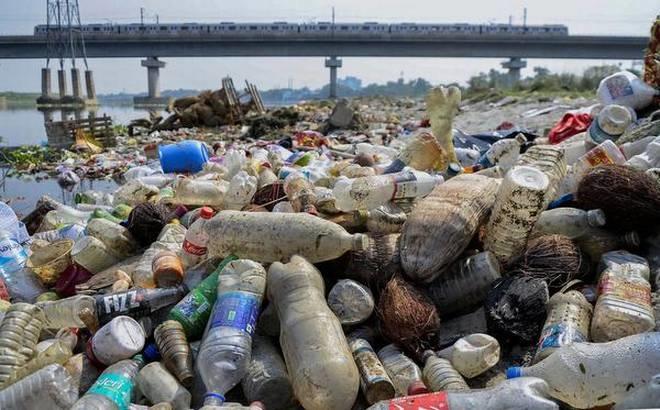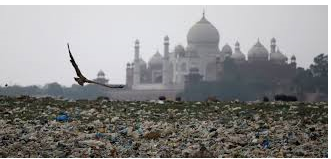The Plastics Crisis

Image Coutesy: The Hindu
World Environment Day (WED) is observed by the United Nations General Assembly each year on June 5 to commemorate the Stockholm Conference on Human Environment in 1972. This year, India is the host country and, in that capacity, has chosen “Beat Plastic Pollution” as the theme for 2018.
The choice of theme is timely since plastic pollution on an unprecedented scale, especially of the oceans, has been highlighted often during the year, and has grabbed media and public attention.
Floating plastic debris in huge swirling patches have been noticed in remote and uninhabited parts of the Pacific Ocean, and micro plastic particles have been found in the digestive tracts of sea creatures in deepest parts of the ocean. Just the other day, a harp seal pup was found dead off the coast of Scotland due to plastic bags in its stomach. In a geography and setting so different from, and yet so similar to, so many cows die regularly in India due to ingestion of plastic bags from garbage dumps. And the BBC’s documentary film Blue Planet 2, sequel to the earlier version and again with commentary by famous naturalist David Attenborough, was also released during the year (currently in some theatres in India), among other things dramatically highlighting the threat from plastics to the oceans and to life on the planet.

One may wish, of course, that World Environment Day had also been used to highlight other major environmental threats, such as climate change – recently further endangered by US President Donald Trump’s withdrawal from the Paris Agreement, or the rampant loss of bio-diversity because of ravages on the natural environment, or egregious industrial pollution as in the Sterile Copper plant in Thoothukudi, or the deliberate and continuing emasculation of environmental regulations in India, particularly under the present government. But then, special themes do also serve their purpose by shining light on specific major problems and bringing to bear focused attention on solutions required.
The problem of plastic pollution has indeed reached monstrous proportions, and it is high time the crisis was tackled on a war footing. Unfortunately, as we shall see, this is not really happening in the places where it is needed most. Some serious efforts are underway in Europe and the US, from which much could be learned, even though global efforts currently lag far behind the problem, given its magnitude. In India, from what little has been evidenced by way of pledges on WED, and given the performance of government and regulatory agencies, there is considerable danger that tomorrow, after the global Day observations are over, we may be left wondering if a “war on plastics” is really on in India.
Scourge of Plastic Wastes
Roughly 300 million tons of plastic waste is generated worldwide each year, approximately equal to the weight of the entire human population. About one million plastic bottles of drinking water are bought each minute around the world, and five trillion disposable plastic bags are used each day. Throw-away plastic packaging of a variety of edible and non-edible goods are ubiquitous, and account for around 35 per cent of the plastic used. It is estimated that about one-third of this plastic packaging escapes the different modes of collection deployed, and end up lying around, or in landfills, or in rivers and other water bodies, wending their way into the sea or leaching into sub-surface waters. It is estimated that 13 million tons of plastic waste end up in the oceans. The very properties of plastics that have made them so popular, such as flexibility of manufacture and use, and long life, have now become humanity’s bane.
Plastic debris may last between 500 and 1000 years, slowly breaking up into tiny micro- or even nano- plastic particles which get consumed by creatures – big and small – and gradually find their way up the food chain back to humans. Plastic waste is now so ubiquitous in the natural environment, that scientists have suggested it could serve as a major indicator of the Anthropocene, the geological era characterised by preponderant impact of human beings! Micro plastics have also been found in 83 per cent of drinking water samples collected from all over the world, India ranking third behind the US with 94 per cent and Lebanon in this regard. We are now actually eating our own plastic waste! What exact effect such microplastics could have on human health is not yet fully understood, although plastics are known to contain various toxins, and also to act as a magnet for others. Similarly, whereas plastic nanoparticles have been observed, little is known about them or their effects, or if and how they interact with the food chain.
Plastic production around the world has grown faster than that of any other material since the 1950s. More waste has been generated in the first decade of this millennium than in the previous 50 years. This is largely due to the fact that an increasing share of plastic products made are meant to be discarded after a single use, so-called “single-use plastics,” a major target of the campaign against plastics at the World Environment Day and in campaigns around the world. Nearly 45 per cent of plastics disposed consist of bags, glasses, cutlery and bottles. And this does not include common single-use items such as food wrappers, packaging material, straws and stirrers, and cigarette filters (the most widely found plastic waste according to a recent survey). Worse still, only a meager 9 per cent of plastics are recycled worldwide! As a result, around 95 per cent of the economic value of such items, estimated to be worth $80-120 million annually, is lost after their first use.
More than 99 per cent of plastics are made from chemicals derived from oil, natural gas and coal, themselves polluting non-renewable resources. The share of global oil consumption used for plastics is expected to treble to 20 per cent by 2050. The share of the global carbon budget attributable to plastics will see an even steeper rise, from one per cent to 15 per cent. (Carbon budget is the amount of total carbon emissions that can be tolerated if temperature rise is to be kept below two degrees Celsius, the internationally accepted goal in the Paris Agreement.) Of course, the more plastics are recycled, the less virgin plastic will need to be made.
Plastics in the Oceans
The extant of threat posed by plastic pollution is perhaps most dramatically illustrated by their penetration into the oceans. Recent studies show that by 2050, there will probably be more plastic than fish in the oceans.
It was known even earlier that the oceans have become the final location for much of the world’s plastic wastes, carried into them by rivers, and then carried along by swirling ocean currents into large floating and continually expanding “garbage patches.” One of the largest such patches is a pair of sizeable stretches of the Pacific Ocean termed the “eastern” and “western garbage patch,” the former off Japan and the latter lying between Hawaii and California, between them holding around 100 million tons of mostly plastic debris.
Midway Atoll, north of the Hawaiian Islands and roughly halfway between Asia and North America, is surrounded by thousands of kilometers of ocean on all sides. Yet Midways’ beaches are suffocating under vast quantities of plastic. Almost all the 1.5 million Albatrosses are believed to have plastics in their digestive systems, and thousands of skeletons of their corpses can be seen with plastic debris where their stomachs used to be.
During the past year, studies have brought out that plastic wastes have not only floated to the remotest parts of the earth’s oceans, but have also reached into its deepest parts. A study team last year found not only a full single-use plastic bag, but also tiny microplastic particles in the guts of sea creatures in the Mariana Trench in the Pacific, the deepest part of the world’s oceans at 36,000 feet!
Ninety percent of this plastic waste in the oceans is carried to them by just 10 river systems, namely the Niger and Nile in Africa, Amur on the border between far eastern Russia and the Manchurian region of China , the Indus mostly in Pakistan, the Meghna/Ganga/Brahmaputra flowing mostly in India, but straddling the deltaic region in Bangladesh, the Hai He, Huang He, Yangtze and Zhu jiang all in China, and the Mekong flowing through the Yunan province of China, Myanmar, Laos,Thailand, Cambodia and Vietnam. It is also estimated that about half of all plastics in the oceans comes from just five countries: China, Indonesia, the Philippines, Thailand and Vietnam, all developing countries but with high economic growth rates and changing lifestyles and consumption patterns.
Corporates and regulations: experiences from Europe
Of course, the US, Europe and Japan generate substantial quantities of plastic waste, but they are clearly better at managing it. Systematic collection, segregation at source preventing plastics from reaching landfills and recycling are regulated and practiced extensively. Many companies and larger corporations are involved in many of these operations, as also in the manufacture of recyclable and compostable plastics.
Experience from the EU suggests that governments and regulations have played a leading role. Along with consumer pressure, these regulations and their enforcement have generated significant momentum in giant corporations who make and use plastics, as well as many smaller players down the retail supply chain, in playing a significant role in substitution, collection and recycling of plastics, and hence reducing plastic wastes.
Estonia, for instance, runs a very successful, government-led Deposit-Return-Scheme (DRS), much like the earlier practice in India involving beverages in glass bottles. Since 2005, Estonian consumers have paid shops a deposit on each bottle of cola or water, which can be discounted on the next purchase if they return the empty bottle. In 2017, 75 per cent of cans and 87 per cent of PET bottles were returned to stores, and collected by the product manufacturers or other companies for recycling. In the beginning both manufacturers and stores were reluctant, but were prodded into acceptance by tough regulations and persuasion by the government.
Earlier this year on Earth Day, the EU announced a decision and strategy to make all plastic packaging reusable or recyclable by 2030. The UK Government declared it would ban all avoidable plastic waste by 2042 and also unveiled a 25-year environment plan setting out, among other things, to eliminate most single-use plastic packaging, make all plastic packaging reusable or recyclable or compostable, and a variety of other measures to increase the collection and recycling of plastic.
Consequent upon these decisions with detailed regulations to follow, 11 leading companies making or using plastics, such as Amcor, Ecover, Evian, L’Oréal, Mars, Marks & Spencer, PepsiCo, Coca-Cola, Unilever, Walmart, and Werner & Mertz, with Nestle following soon after, committed themselves to using 100 per cent reusable, recyclable or compostable plastics by 2025. PlasticsEurope, an industry association in the EU, has adopted a voluntary target of recycling 60 per cent of plastic packaging by 2030 and 100 per cent by 2040. All clearly demonstrate the power of strong regulations and a commitment by governments to ensure compliance.
Many commentators in the UK, however, have pointed to the additional need for better coordination between governmental agencies and institutions, since responsibilities for waste handling often overlap or fall between different departments. For this reason, Scotland, departing from the practice in Britain, has set up a dedicated agency called Zero Waste Scotland to deliver on the goals of the Scottish government’s circular economy strategy. In fact, “circular economy” has become quite the buzzword in Europe with even industry circles talking about closing the current linear manufacturer-consumer-waste chain and several universities having whole departments with that title.
The Indian scene
In contrast, but unsurprisingly, the scenario in India is quite dismal. Even existing regulations are mostly lying unimplemented, such as the Waste Handling Rules and the almost unknown Plastic Waste (Management and Handling) Rules 2011. Waste segregation is barely, if at all, implemented in the country, there is as much uncollected waste as garbage collected, and landfills are not lined allowing all manner of toxins to leach into the soil and aquifers. A ban on plastic bags of thickness less than 50 microns even in the national capital was no sooner announced than ignored. This is not surprising given the laxity with which most environmental regulations are followed, and the total lack of enforcement by concerned government agencies.

The signals emanating from the very top of the Indian government earlier, and at the WED commemoration, were highly disheartening to say the least.
Last year, the Union Minister for Petroleum Dharmendra Pradhan declared that India lamented the low per capita consumption of plastics in India, currently at around 11kg/year, compared to 109kg in the US and 35kg in China, an Indian “achievement” ironically highlighted by Prime Minister Modi at the WED ceremony, and promised to double it to 20 kg by 2022!
During the WED week, India conducted actions to clean 25 beaches and 24 rivers, not even scratching the surface of the problem. The prime minister promised to ban single-use plastics in short time which, bar some miracle, will most likely go the way of all previous bans. And betraying a poorly informed understanding of environmental issues, the prime minister proudly claimed that the invitation to India to host WED this year with the theme of combating the problem of plastic waste was a tribute to its leading contribution to fighting climate change, conflating two very different issues! One would love to be proved wrong, but chances of India achieving anything substantial to beat plastic pollution are quite remote, at least as of now.
Get the latest reports & analysis with people's perspective on Protests, movements & deep analytical videos, discussions of the current affairs in your Telegram app. Subscribe to NewsClick's Telegram channel & get Real-Time updates on stories, as they get published on our website.























